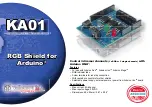
Commander SE Advanced User Guide
5
Issue Number: 4
1 Serial Communications
1.1 Introduction
•
2-wire EIA485 via RJ45 connector
•
ANSI and Modbus RTU protocols supported
A serial communications link enables one or more drives to be used in systems controlled by a host unit such as a PLC
(Programmable Logic Controller) or computer. The communications link for the drive uses the EIA485, also known as RS485,
as standard for the hardware interface. The EIA422 hardware interface is also supported.
The Commander SE drive has a standard 2-wire EIA485 half-duplex interface that enables all drive set-up, operation and
monitoring to be accomplished if required. Therefore, it is possible to control the drive entirely by the EIA485 interface without
the need for other control cabling.
A host controller can operate up to thirty-two EIA485 devices with the use of one line buffer. Further buffers will increase this
number if necessary. Each transmitter/receiver within a drive (with the internal termination and external pull-up and pull-down
resistors disconnected) loads the EIA485 lines by 2 unit loads. This means that up to 15 drives can be connected in a single
group to one line buffer.
ANSI
When additional line buffers are used, up to 81 drives can be operated by the host controller. In this case the drives are
organised in a maximum of 9 groups of 9 drives each. A particular drive or group of drives can be given commands
without affecting other drives or groups of drives respectively.
Modbus RTU
When additional line buffers are used, up to 247 drives can be operated by the host controller.
The serial communications port of the drive is situated at the RJ45 connector. Detailed instructions on how to terminate an
RJ45 connector to comms cable are shown on the pages following. The EIA485 2-wire port is isolated from the power stage
but not isolated from the other control terminals. The EIA422 hardware interface is also supported.
EIA232 to EIA485 Communications
An external EIA232 hardware interface such as a PC cannot be used with the 2-wire EIA485 interface of the drive. Therefore
a suitable converter is required. This converter must have the hardware and software support to tri-state (disable) the
transmit buffer following message transmission. Otherwise the Commander SE EIA485 transmitter will not be successful in
transmitting a reply as the host transmitter will cause contention of the 2-wire interface.
Examples of EIA232 to EIA485 converters (one to one):
•
Control Techniques SE71 communications lead (CT Part No. 4500-0087)
The Control Techniques SE71 communications lead is a specifically designed EIA232 to EIA485 converter to link a PC to
a Commander SE drive.
•
Amplicon 485Fi
These converters are for one to one connection between a PC and the Commander SE drive, They do not have
'multi-drop' capability.
The Control Techniques SE71 communications lead (part no: 4500-0087) and the Amplicon 485Fi converter are both
isolated converters.
The SE71 2-wire EIA485 Serial Communications Converter – CT Part No: 4500-0087
The SE71 2-wire EIA485 serial communications converter enables the use of serial communications with Commander SE
using a software package such as SE Soft. This allows access of all the drives parameters and advanced function menus.
The SE71 2-wire EIA485 serial communications converter is only intended for the purpose of commissioning a drive.
Therefore:
•
It is not suitable for permanent installation
•
It does not provide connectivity to an EIA485 based network
When this converter is used on Commander SE and a true EIA232 host / master such as a PC, then no external power
supply is required. This is because the converter sources its power from both the drive and the EIA232 ports.
However, if the converter is attached to a host / master device that does not have a standard EIA232 port then an external
power supply may be required.
The SE71 2-wire EIA serial communication converter does not directly use any of the hand shaking functions that are
available on a standard EIA232 port, but does utilise two of the hand shaking pins (4 and 7) as a source of power. If these
signals are not available then a +10V supply should be applied to pins 4 and 7 with respect to pin 5 of the 9-way D-type
connector.
NOTE
NOTE






































